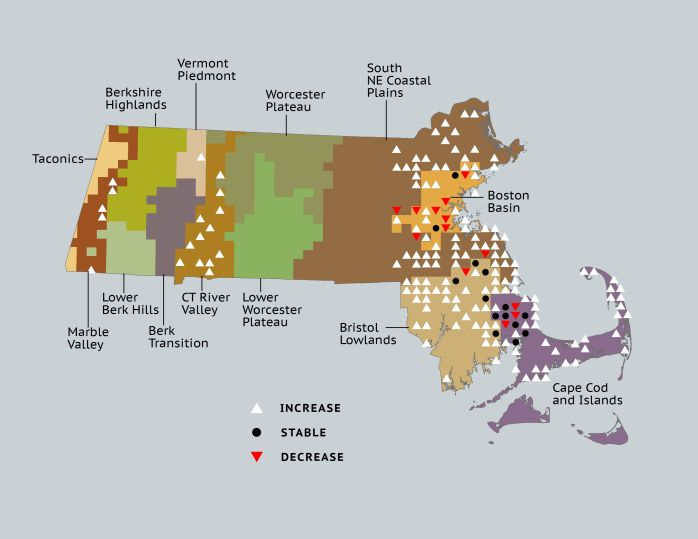Find a Bird
Fish Crow
Corvus ossifragus

Local and strongly increasing
“Crows everywhere are equally black.” – Chinese proverb
Fish Crows are smaller than American Crows and show a strong preference for wetland habitat in much of their range. Even so, these two species are so similar that voice is the best way to identify an individual. Fish Crows’ nasal uh uh uh cries are easy to distinguish from the deeper caw caw caw of American Crows. This species is endemic to the United States and ranges all along the Atlantic and Gulf Coasts, with Massachusetts near the northern edge of its breeding range. Although they are much less widespread than American Crows, areas of overlap do exist in a number of areas.
Historic Status
On March 16, 1875, the man who would eventually become the first president of Mass Audubon, William Brewster, spotted the first Fish Crow ever recorded in Massachusetts, in Cambridge. Single sightings eventually followed along the coast and up the Connecticut River Valley for decades (Brewster 1906, Forbush 1929). Natural and explainable confusion between Fish Crows and American Crows might have caused this bird to be underreported in the past, but by 1973, it had positively staked its claim to Massachusetts as a breeding ground (Veit and Petersen 1993). Soon thereafter, Fish Crows began to regularly appear on Massachusetts Christmas Bird Counts. Legal protections against human depredations came in the 1970s, which might explain the Fish Crow's northward range expansion at that time. As a notorious egg stealers, Fish Crows may have been following the resurgence of herons as they recovered and gradually moved northward during the twentieth century.
Atlas 1 Distribution
Atlas 1 surveys took place just when the first recorded breeding Fish Crows were moving into Massachusetts. As might be expected for a primarily coastal species expanding from the south, Fish Crows were initially most concentrated in the southeastern part of the state. A small but noticeable scattering (8 blocks) of breeding Fish Crows could be found in the Boston Basin, as well as at the inner edge of the Coastal Plains. Another half-dozen blocks were occupied in the Bristol/Narragansett Lowlands, though the Cape and Islands region was truly the center of Fish Crows’ distribution in Massachusetts. No fewer than 10 blocks with breeding evidence were clustered around the westernmost part of the ecoregion in southern Plymouth County.
Atlas 2 Distribution and Change
Always on the lookout for new sources of food to exploit, Fish Crows tended to follow river systems inland between the two Atlas projects. In Atlas 2, the birds were already present in multiple blocks in the Marble Valleys, and the species occupied more than 20% of the Connecticut River Valley. Though essentially absent from the Worcester Plateau regions, Fish Crows had infiltrated fairly far into the Coastal Plains, where they appeared in more than 50 new blocks overall. The Boston Basin posted only a small expansion, while Fish Crows colonized dozens of new blocks throughout the southeastern regions, where their presence was strongest.
Atlas 1 Map

Atlas 2 Map

Atlas Change Map

Ecoregion Data
Atlas 1 | Atlas 2 | Change | ||||||
Ecoregion | # Blocks | % Blocks | % of Range | # Blocks | % Blocks | % of Range | Change in # Blocks | Change in % Blocks |
Taconic Mountains | 0 | 0.0 | 0.0 | 0 | 0.0 | 0.0 | 0 | 0.0 |
Marble Valleys/Housatonic Valley | 0 | 0.0 | 0.0 | 5 | 12.8 | 2.7 | 5 | 12.8 |
Berkshire Highlands | 0 | 0.0 | 0.0 | 0 | 0.0 | 0.0 | 0 | 0.0 |
Lower Berkshire Hills | 0 | 0.0 | 0.0 | 0 | 0.0 | 0.0 | 0 | 0.0 |
Vermont Piedmont | 0 | 0.0 | 0.0 | 2 | 11.8 | 1.1 | 1 | 8.3 |
Berkshire Transition | 0 | 0.0 | 0.0 | 0 | 0.0 | 0.0 | 0 | 0.0 |
Connecticut River Valley | 0 | 0.0 | 0.0 | 14 | 21.5 | 7.7 | 12 | 25.0 |
Worcester Plateau | 0 | 0.0 | 0.0 | 1 | 1.1 | 0.5 | 0 | 0.0 |
Lower Worcester Plateau | 0 | 0.0 | 0.0 | 0 | 0.0 | 0.0 | 0 | 0.0 |
S. New England Coastal Plains and Hills | 3 | 1.1 | 11.1 | 55 | 19.4 | 30.1 | 48 | 21.2 |
Boston Basin | 8 | 14.3 | 29.6 | 17 | 30.4 | 9.3 | 9 | 16.4 |
Bristol and Narragansett Lowlands | 6 | 5.7 | 22.2 | 41 | 36.0 | 22.4 | 35 | 34.7 |
Cape Cod and Islands | 10 | 7.4 | 37.0 | 48 | 33.3 | 26.2 | 33 | 27.5 |
Statewide Total | 27 | 2.8 | 100.0 | 183 | 17.6 | 100.0 | 143 | 17.2 |
Notes
The Fish Crow shows a significant increasing Breeding Bird Survey trend in the New England/Mid-Atlantic Region.



